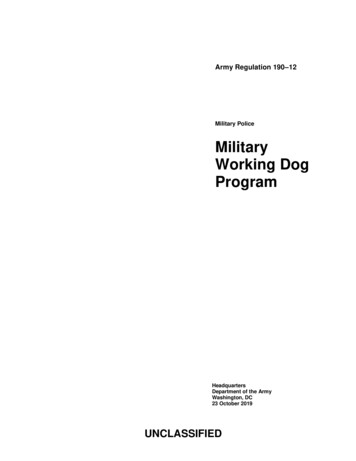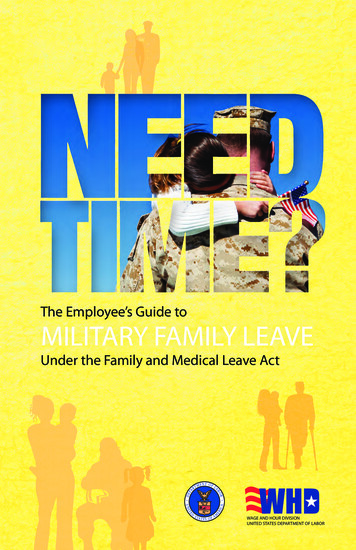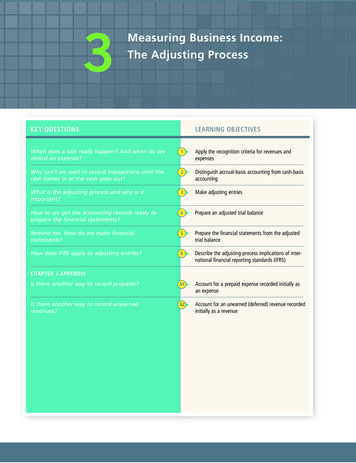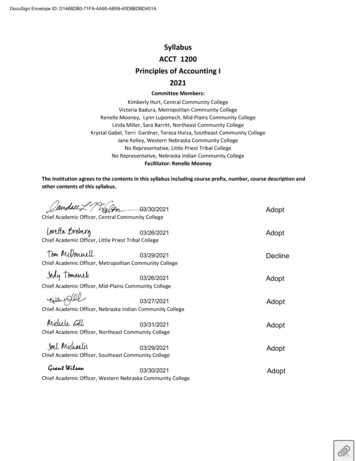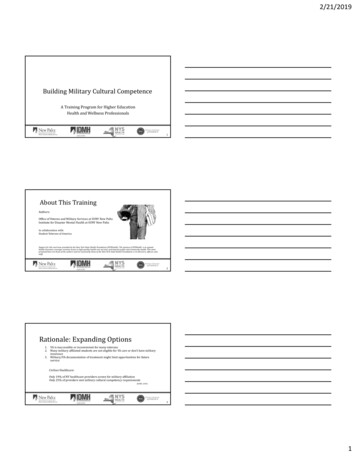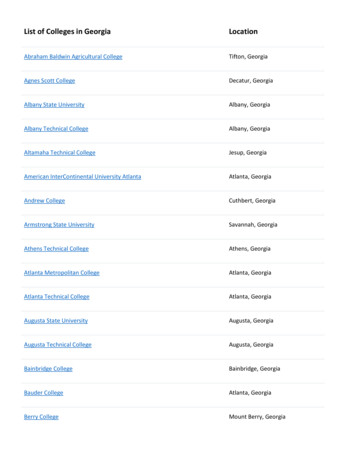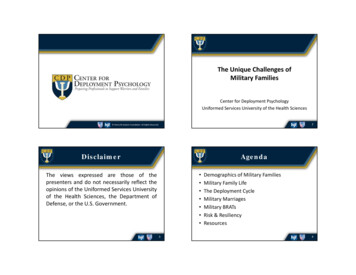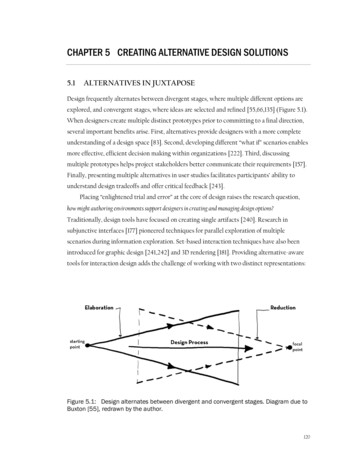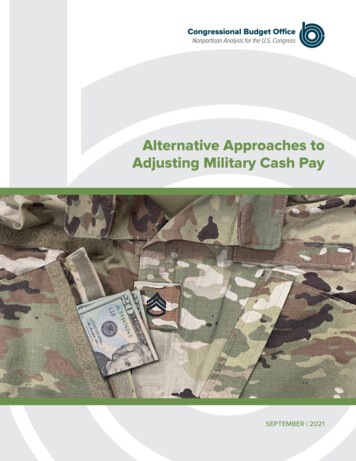
Transcription
Alternative Approaches toAdjusting Military Cash PayR. L. Rebach/Congressional Budget OfficeSEPTEMBER 2021
At a GlanceEach year, the Department of Defense (DoD) adjusts its regular military compensation, primarily tohelp attract and retain high-quality personnel. That compensation includes basic pay, housing andfood allowances, and the tax advantage that arises because those allowances are not subject to federalincome tax. Unless the Congress passes legislation directing otherwise, the law requires DoD to usethe employment cost index (ECI) to make annual adjustments to basic pay, the largest component ofregular military compensation. The department uses other methods to adjust the housing and foodallowances. Currently, regular military compensation substantially exceeds DoD’s benchmark goal,which equals the 70th percentile of earnings for comparable civilians (meaning that 30 percent ofcomparable civilians would earn more).In this report, the Congressional Budget Office examines two approaches to making the annualadjustments to regular cash pay (that is, regular military compensation excluding the tax advantage).Adjusting Basic Pay With an Alternative Wage Index. CBO created an alternative wage indextailored to the characteristics of military personnel and a broad index for the entire labor force,comparable to the ECI, but the agency found only small differences between them. From 2004 to2020, basic pay raises under CBO’s alternative index would have been broadly similar to those underits all-labor-force index, although slightly higher or lower in some years. The agency’s alternativeindex and the military-adjusted indexes of other researchers were sensitive to the methods used toconstruct them; their cumulative effect on basic pay over time was also sensitive to the starting year.The changes in those indexes varied from year to year.Transitioning to an alternative index would entail some administrative costs and could garner lesssupport than the ECI from some stakeholders. Effects on recruiting and retention might also besignificant considerations in evaluating an alternative index.Adjusting All Components of Regular Cash Pay With the ECI. CBO found that applying theECI to all elements of regular cash pay could help slow the growth in compensation costs. If thatmethod had been applied from 2004 to 2020, it would have reduced costs and helped narrow thegap between regular military compensation and DoD’s 70th percentile goal. If applied in the future,it could slightly slow the growth in spending for regular cash pay and associated expenses. In 2030, itcould reduce annual costs by roughly 3 billion (or 1.7 percent). But other costs, such as special andincentive pays to address any recruiting and retention problems that might arise, could erode some orall of the savings.www.cbo.gov/publication/57192
ContentsBackground1Composition of Military Compensation1DoD’s Current Method of Adjusting Regular Military Cash Pay2Reasons to Consider Alternative Approaches to Adjusting Military Cash Pay3Adjusting Basic Pay With a Military-Adjusted Wage-Growth Index Instead of a Broad Labor Force Index3Advantages and Disadvantages of Adjusting Basic Pay With the ECI4Constructing Wage-Growth Indexes From the Current Population Survey4CBO’s All-Labor-Force Index4CBO’s Military-Adjusted Index5Comparing the All-Labor-Force and Military-Adjusted Indexes5Comparing the Effects of the All-Labor-Force and Military-Adjusted Indexes on Basic Pay6Comparing CBO’s and RAND’s Findings7Adjusting All Elements of Regular Military Cash Pay With the ECI8Implementing a Single Index for All Elements of Regular Cash Pay9How Adjusting All Elements of Regular Cash Pay With the ECI Would Have Affected Its Previous Growth9Effects of the Faster Growth in DoD’s Housing Costs10Scenarios for Projecting Regular Cash Pay From 2020 to 203010Increasing Regular Cash Pay With the ECI11Potential Effects on Recruiting and Retention12List of Figures13About This Document14
NotesUnless this report indicates otherwise, all years referred to are federal fiscal years, which run fromOctober 1 to September 30 and are designated by the calendar year in which they end.All costs are expressed in nominal dollars unless otherwise stated.
Alternative Approaches to AdjustingMilitary Cash PayThe Department of Defense (DoD) annually adjustsregular military compensation for its military personnel,in large part to be competitive with the civilian sectorand, consequently, to help attract and retain servicemembers to fulfill the department’s missions. Regularmilitary compensation includes basic pay, allowancesfor housing and food, and the tax advantage that arisesbecause those allowances are not subject to federal incometax. This report focuses on regular cash pay, which theCongressional Budget Office defines as regular militarycompensation excluding the tax advantage. Under currentlaw, the annual adjustment to basic pay—the largest component of regular cash pay—is linked to changes in theemployment cost index (ECI) unless legislation is enactedthat mandates a different adjustment. Other methods areused to change the housing and food allowances.Those adjustment methods may not reflect pay changesamong the civilian workers most comparable to military personnel. In addition, the department’s ability toachieve its other priorities, such as procuring weapons,sustaining research and development of new equipment,and maintaining systems, may be limited if DoD paysmore than necessary for personnel. Currently, regularmilitary compensation exceeds DoD’s benchmark goal,which is equal to the 70th percentile of wages and salaries for comparable civilians.In this report, CBO examines the implications of twodifferent approaches to adjusting regular cash pay: Adjusting basic pay with an alternative wage indextailored to the age and education level of militarypersonnel compared with adjusting it with a broadlabor force index, such as the ECI, which does notaccount for such demographic information, orof a number of elements, CBO’s analysis focused on thegrowth in the elements of regular cash pay because theymake up a large portion of service members’ total compensation. DoD annually adjusts regular cash pay with adifferent method for each element, largely to be competitive with the civilian sector.Composition of Military CompensationCompensation for military personnel is a mix of cashearnings and in-kind benefits received while in service,as well as the deferred pay and benefits service membersmay receive after leaving. In 2020, DoD spent about 160 billion, or about 25 percent, of its base budget of 630 billion for cash pay and benefits for current servicemembers (active-duty and activated reserves). DoD’s basebudget consists of funding for the department’s normalpeacetime operations and excludes supplemental appropriations for wars and other contingency operations.The three elements of regular cash pay—basic pay andallowances for housing and food—that are the mostvisible components of service members’ compensationaccounted for just over half of DoD’s total spending forcash pay and benefits in 2020 (see Figure 1). Previousstudies have shown that the decisions of potentialrecruits and current service members to sign up for orstay in the military are influenced by changes in regularcash pay and bonuses but are less responsive to changesin noncash and deferred compensation.1 Because thisreport focuses on the costs DoD incurs for current military service members, CBO excluded the tax advantagefrom its definition of regular cash pay. Regular cash payalso excludes special and incentive pays, because thosetypes of pay vary by occupation, job assignment, andlocation. Adjusting all components of regular cash pay(excluding the tax advantage) with the ECI.BackgroundThe composition, amount, and growth of military compensation are key factors in attracting and retaining military personnel. Although military compensation consists1. For more information on how military pay affects DoD’srecruiting and retention, see Congressional Budget Office,Approaches to Changing Military Compensation (January 2020),www.cbo.gov/publication/55648; and Beth J. Asch and others,Setting the Level and Annual Adjustment of Military Pay (RANDCorporation, 2020), www.rand.org/pubs/research reports/RRA368-1.html.
2ALTERNATIVE APPROACHES TO ADJUSTING MILITARY CASH PAYSeptember 2021Figure 1 .The Department of Defense’s Funding for the Compensation of Military Personnel, 2020Billions of 2020 DollarsRegular Cash Pay, 84Basic Pay,59HousingAllowances,21Food Allowance, 4Retirees’HealthCare, 8Special or IncentivePays and Allowances, 7Retirement Accrualand Contributions toThrift Savings Plan, 19Deferred, 27OtherNoncash,11Active-DutyHealth Care,34Regular military cashpay, which includes basicpay and allowancesfor housing and food,accounts for a major shareof total compensationfor service members.Basic pay is the largestcomponent of regularcash pay.CurrentNoncash, 45Data source: Congressional Budget Office, using data from the Department of Defense. See www.cbo.gov/publications/57192#data.The remaining portion of compensation consists ofspecial and incentive pays; deferred pay, such as retirement pay; current noncash benefits, such as health care,children’s education, government-provided housing, andfamily services for currently serving members and theirfamilies; and deferred noncash benefits, such as healthcare and commissary access for retirees.DoD’s Current Method of Adjusting RegularMilitary Cash PayUnder current law, the basic pay raise for military servicemembers—unless the Congress passes legislation to thecontrary—is determined by the rate of change in theECI for wages and salaries for private-sector workers,which is constructed by the Bureau of Labor Statistics(BLS). Although the basic pay increase has beenlinked to the ECI for decades, the National DefenseAuthorization Act for Fiscal Year 2004 established thatthe default pay raise would equal the ECI beginning in2007. Specifically, the pay increase for a given calendaryear is determined by the increase in the ECI from thethird quarter of the third preceding calendar year to thethird quarter of the second preceding calendar year. Thatmethod results in a lag of about 15 months betweenthe increase in the ECI and the corresponding basic payincrease.Under the law, the President can recommend an alternative pay adjustment (which must be approved by theCongress), or the Congress may pass legislation thatsupersedes the automatic adjustment or an adjustmentproposed by the President.The military’s basic pay raises were set higher thanthe increases in the ECI in the 2000s and have eithermatched or been lower than the ECI increases since2011. Although the basic pay raise generally applies toall military personnel, the Congress provided additional,targeted raises to service members within certain paygrades and years of service in the early 2000s to addressspecific retention problems.Different rules are used to adjust allowances for housingand food. By law, the Secretary of Defense determineshousing allowance rates annually to provide “adequatehousing.”2 To do that, DoD uses data on vacancies forselected rental housing in each local area. The monthlyfood allowance is set annually and is based on theDepartment of Agriculture’s index for the price of food.2. See Pay and Allowances of the Uniformed Services, 37 U.S.C.,§403.
September 2021Housing allowances differ by rank, by whether a servicemember has dependents, and by location. The foodallowance varies according to whether service membersare officers or enlisted personnel; enlisted personnelreceive larger allotments than officers do. Service members may choose to pay more for housing and food thanthey receive in their allowances or to pay less and keepthe extra tax-free allowances.Reasons to Consider AlternativeApproaches to Adjusting MilitaryCash PayThe amount of regular cash pay for service members (asmeasured using DoD’s definition) has exceeded DoD’sbenchmark goal. CBO’s and the RAND Corporation’sresearch indicates that, in 2018, regular cash pay forenlisted personnel was at roughly the 90th percentile ofthe earnings of civilian workers with comparable years ofexperience and some college education, about 20 percentiles above the benchmark.3 In addition, research indicates that, overall, DoD has successfully met its staffingneeds for the force. For example, the share of active-dutyenlisted recruits who are considered high quality—thosewith a high school diploma and an above-average scoreon the Armed Forces Qualification Test—has grownsince at least the 2000s. Those data raise questions aboutwhether DoD is paying more for its personnel than isnecessary to meet its goals.The growth in regular cash pay has broad implicationsfor DoD’s future operations. If military pay continuedto exceed DoD’s goal in the future, the departmentwould be more likely to continue to attract and retainhigh-quality, productive personnel, resulting in greaterreadiness to conduct military operations. But DoDmight be able to pay less and still reach its personnelgoals, while possibly meeting other objectives, such asprocuring weapons. If pay growth was too slow, regularcash pay would eventually fall below DoD’s goal, whichcould make it difficult for the department to achieve itsrecruiting and retention goals.In response to those pay implications, CBO examinedtwo questions in its analysis:3. For comparisons of military and civilian pay, see CongressionalBudget Office, Approaches to Changing Military Compensation(January 2020), www.cbo.gov/publication/55648; and BethJ. Asch and others, Setting the Level and Annual Adjustment ofMilitary Pay (RAND Corporation, 2020), www.rand.org/pubs/research reports/RRA368-1.html.ALTERNATIVE APPROACHES TO ADJUSTING MILITARY CASH PAY First, how would an alternative, or military-adjusted,wage index that reflected the characteristics of servicemembers compare with a broad labor force indexlike the ECI for setting the annual basic pay raise?It is unclear whether the rate of change of the ECIor other broad labor force index is a good indicatorof pay changes in the labor market in which DoDcompetes. Collectively, military personnel and civilianworkers have different attributes, including age (orwork experience), education, occupation, and gender.CBO created a military-adjusted wage index and anall-labor-force index to explore that issue. Second, what would be the implications of applyingone wage index to all regular cash pay (basic pay andallowances for housing and food)? That approachwould make the method for increasing military paymore comparable to that of civilians, whose payhas to cover costs for housing and food that DoDcompensates for separately. CBO examined the effectsthat such a policy would have had on DoD’s costsover the past 15 years and projected the effects that itmight have over the next 10 years.Adjusting Basic Pay With a MilitaryAdjusted Wage-Growth Index Insteadof a Broad Labor Force IndexIn the first part of its analysis, CBO examined how amilitary-adjusted index that reflected the characteristicsof service members (such as age and education) wouldcompare with a broad labor force index in setting theannual basic pay raise. The agency found only smalldifferences between the indexes: Growth in CBO’smilitary- adjusted index was slightly higher in someyears and slightly lower in others than that in the broadindex it created. Moreover, the military-adjusted indexappeared to vary more from year to year than the broadindex, which could lead to larger swings (both positiveand negative) in pay raises.CBO found a relatively small difference between 2004and 2020 when it compared the effects on basic pay ofusing its all-labor-force index and its military-adjustedindex. Those results appear sensitive to the methodsused to construct the military-adjusted index and thestarting year for the comparison. For example, an indexthat RAND created resulted in annual changes that weresmaller than those in the ECI during the same period.Those findings suggest that using a military-adjustedindex instead of a broad index like the ECI wouldprobably have little effect on the future growth of basic3
4ALTERNATIVE APPROACHES TO ADJUSTING MILITARY CASH PAYpay. Furthermore, transitioning to such a customizedindex would entail some administrative costs and couldgarner less support than the ECI from some stakeholdersbecause it would not be created by a neutral third party.Advantages and Disadvantages of AdjustingBasic Pay With the ECIThe ECI may not reflect pay changes among the civilianworkers who are most similar to military service members. The index is based on the National CompensationSurvey of employers’ payrolls conducted by BLS. Itmeasures the change in compensation costs in the U.S.economy and is weighted to reflect the industrial andoccupational mix of jobs in specific years. Because thesurvey tracks specific jobs, it reflects the increase inwages for those jobs, not the wage growth one personmay experience. The ECI has several different series;DoD uses the wage and salary series for private workers(excluding benefits).Adjusting basic pay with the ECI has several advantages.It is a large, nationally recognized index designed andmeasured by a third party (BLS) rather than by DoD,and it is publicly available. Because it holds the occupational and industrial distribution of jobs constant overtime, it is more stable than indexes that do not use thatapproach. For example, if a job disappears from the survey sample during a recession, it is replaced by a job withthe same occupational and industrial mix. The ECI isalso less prone to respondents’ recall errors than household survey data.Using the ECI has some disadvantages as well: Becausethe occupational and industrial mix is infrequentlyreweighted, it does not fully reflect the current job mixavailable to U.S. workers. The current series reflects themix of jobs in the U.S. economy in 2012. Moreover, theECI is not designed to reflect the age of military servicemembers or their educational and occupational characteristics. If wage growth in the private sector differs bythose characteristics, the ECI may not reflect the actualcivilian opportunities available to military personnel orthe employment instability they might experience in thecivilian sector. The educational attainment of militarypersonnel (both enlisted service members and officers)differs from that of civilians (see Figure 2). For this study,CBO used data on the educational attainment of servicemembers from DoD’s Status of Forces Surveys, whichare regarded as a more reliable source for those data thanadministrative records.September 2021Constructing Wage-Growth Indexes From theCurrent Population SurveyBecause the ECI tracks jobs, not individuals, it does notinclude information on the characteristics of the workersfilling those jobs, which CBO needed to construct itsmilitary- adjusted index. Instead, the agency used theCurrent Population Survey (CPS), a large national surveythat contains information on the age, educational attainment, and occupation of civilian workers. Respondentsto the CPS self-report employment, earnings, and demographic characteristics, such as age and education.As a first step, CBO constructed an all-labor-force indexto examine the differences in wage growth between theECI and CPS data. The agency then used the all-laborforce index in place of the ECI in its analysis to ensurethat any differences in the indexes were due to characteristics of the military population rather than to intrinsicdifferences in the surveys.CBO’s All-Labor-Force IndexCBO’s all-labor-force index, which is based on monthlyCPS data, includes all full- and part-time workers inthe private-sector civilian workforce but excludes peoplewho are self-employed or who work on farms. It is constructed from the average wages of workers, not jobs, foreach fiscal year and from associated annual growth rates.The index corrects for misreporting of hours worked byrespondents.4Unlike the ECI, CBO’s index incorporates changes inthe industrial and occupational structure of the economy to reflect current opportunities available to servicemembers. CBO explored keeping the occupation andindustry composition of jobs in the all-labor-force indexconstant over the years, similar to the method used forthe ECI series, but opted not to do so, in part becausethe average annual growth in the two indexes over thepast decade and a half was similar.The average annual growth in CBO’s all-labor-force indexbetween 2004 and 2019 was comparable to the averageannual growth in the ECI. Year-to-year growth in theall-labor-force index was also broadly similar in pattern tothat in the ECI over the same period (see Figure 3). That4. In this report, CBO uses the same basic methods to calculatewages as outlined in Congressional Budget Office, The Effectsof a Minimum-Wage Increase on Employment and Family Income(February 2014), www.cbo.gov/publication/44995. For anupdate on those methods, see Congressional Budget Office, TheEffects on Employment and Family Income of Increasing the FederalMinimum Wage (July 2019), www.cbo.gov/publication/55410.
September 2021ALTERNATIVE APPROACHES TO ADJUSTING MILITARY CASH PAYFigure 2 .Educational Attainment of Military and Civilian WorkersPercent60High SchoolDiploma or LessSome College, IncludingAssociate’s DegreeBachelor’s Degreeor nWorkers 20200200120192001201927200127The share of people witha high school diploma orless is larger for civilianworkers than for militarypersonnel, primarilybecause the militaryaccepts few recruitswithout a diploma.The share of people withat least a bachelor’sdegree is larger for civilianworkers than for militarypersonnel. Althoughvirtually all officers haveat least a college degree,they make up less than20 percent of militarypersonnel.2019Data source: Congressional Budget Office, using data from the Department of Defense and Current Population Survey data from IPUMS-CPS. See www.cbo.gov/publications/57192#data.result suggests that the findings derived from CBO’s alllabor-force index would also apply to the ECI.CBO’s Military-Adjusted IndexCBO’s military-adjusted index controls for the educational level and age of military personnel, two characteristics by which wage growth has differed in the past. Toconstruct that index, CBO used DoD’s administrativeand survey data to categorize military personnel intoeducational and age groups, extracted wage data fromthe CPS for civilians with corresponding characteristics,and weighted the civilian data to reflect the compositionof the military personnel. In addition, CBO’s methodallowed the mix of age and education of military personnel to change annually.CBO did not adjust for occupation within the military.Initial explorations to do so using the ECI’s separateseries for broad occupational groups did not yield anindex markedly different from the ECI, so CBO did notpursue it further. The agency also did not adjust for gender because military pay is gender-neutral. Because datawere not available in the CPS, CBO did not adjust forother characteristics by which military personnel differfrom civilians, such as their scores on the Armed ForcesQualification Test, which is an aptitude test that predictsjob performance among service members.Previously, researchers at RAND also constructed amilitary-adjusted wage index, known as the DefenseEmployment Cost Index (DECI). CBO’s approach waslargely the same, although the specific methods differedin some respects.5Comparing the All-Labor-Force andMilitary-Adjusted IndexesCBO’s alternative all-labor-force index and military- adjusted index exhibited broadly similar trends (seeFigure 4). Both indexes grew at an average rate of about2.5 percent annually from 2004 through 2019. Changesin the military-adjusted index were not consistentlyabove or below those of the all-labor-force index for most5. For details on RAND’s approach and findings, see Beth J.Asch and others, Setting the Level and Annual Adjustment ofMilitary Pay (RAND Corporation, 2020), www.rand.org/pubs/research reports/RRA368-1.html.5
6ALTERNATIVE APPROACHES TO ADJUSTING MILITARY CASH PAYSeptember 2021Figure 3 .Annual Growth in CBO’s All-Labor-Force Index and the ECIPercent5The annual rate of changein the all-labor-force indexand the ECI increasedfrom 2004 to 2008,dipped sharply from 2008to 2010, and then beganto rise after 2010. (Thoseindexes do not includea time lag like the oneDoD uses to set militarypay raises.) Although theaverage annual changewas almost identical for2004 to 2019, CBO’s indexwas more volatile thanthe ECI.4CBO’s All-Labor-Force Index3ECI2102004200920142019Data source: Congressional Budget Office, using data from the Bureau of Labor Statistics and Current Population Survey data from IPUMS-CPS.See www.cbo.gov/publications/57192#data.DoD Department of Defense; ECI employment cost index.of that period. In other words, it is not clear whether amilitary- adjusted index would systematically differ froman all-labor-force index such as the ECI over the longrun. The differences in the indexes depend on the composition of the military force but also on the effects ofage and education on wages in the civilian sector, whichvary over time.Although an adjusted measure may, in theory, capturethe civilian opportunities available to military personnelbetter than an unadjusted index, the way that adjustmentis accomplished could influence the trend in the resulting index. For example, adjusting for gender or includingonly full-time civilian workers (instead of both full-timeand part-time workers) could influence the level andtrend of the index.In addition, using a military-adjusted index would entailsome administrative costs and stakeholder buy-in thatwould not apply if DoD continued using the ECI.Comparing the Effects of the All-Labor-Forceand Military-Adjusted Indexes on Basic PayCBO found that, since 2004, the growth in basic paywould have been broadly similar using either the alllabor-force index or the military-adjusted index. (Thatresult is based on the assumption that enacted pay raiseswould not have been higher or lower than the rate ofgrowth in the all-labor-force index.) However, the cumulative effect of the all-labor-force index or the military- adjusted index on basic pay over time was sensitive to thestarting point (or benchmark year).To illustrate that sensitivity to the starting point, CBOcalculated the average basic pay for the E-4 pay grade incalendar year 2020 using both indexes but under twoseparate scenarios: one starting in calendar year 2004 andthe other starting a year later (see Figure 5). (Basic payincreases go into effect at the beginning of the calendaryear.) Pay grade E-4 is the most common single rankamong enlisted service members and the typical rankattained at the end of the first term of service. CBO’sapproach removed the effect of changes in the number
September 2021ALTERNATIVE APPROACHES TO ADJUSTING MILITARY CASH PAYFigure 4 .Wage Growth in CBO’s All-Labor-Force and Military-Adjusted IndexesAnnual Growth in WagesPercentAfter a sharp declineduring the 2007–2009recession, the annualrate of change for bothindexes increasedbeginning in 2011.5CBO’s MilitaryAdjusted Index43CBO’sAll-LaborForce Index21020042009Percentage Points1.520142019Difference in Annual Growth in WagesIn recent years, theearnings of workers with ahigh school diploma havegrown at a rate similarto or slightly higher thanthat of workers with acollege degree, whichpartly explains the highergrowth in the militaryadjusted index after 2014.All-Labor-Force Index Higher Than Military-Adjusted Index1.0Since 2004, annual wagegrowth in the all-laborforce index has been bothhigher and lower thanthe wage growth in themilitary-adjusted index,and those deviations havelargely offset each other.0.50 0.5 1.0 1.5Military-Adjusted Index Higher Than All-Labor-Force Index2004200920142019Data source: Congressional Budget Office, using Current Population Survey data from IPUMS-CPS. See www.cbo.gov/publications/57192#data.of personnel and the grade structure of the force. Thecalculations excluded other compensation elements thatare tied to basic pay, such as the accrual of retirementbenefits. Indexes included a time lag similar to the oneDoD uses to determine pay raises. For instance, growthin calendar year 2005 was calculated as the change in thegrowth in the index for fiscal year 2003 compared withthat for fiscal year 2002. CBO found that, when 2004was the benchmark year, the two indexes would haveresulted in basic pay that differed by a small percentage.That difference shrank when 2005 was the benchmarkyear and reversed when 2014 was used as the startingpoint.Comparing CBO’s and RAND’s FindingsUsing CPS data, RAND researchers recently updated anearlier analysis that developed a military-adjusted index,the Defense Employment Cost Index. The earlier analysis adjusted for age, education, and occupation. The neweffort revised the earlier analysis by adjusting for age,education, and gender; it also changed data sources andupdated the analysis through 2019.In its earlier analysis, RAND showed a trend in the average annual wage growth measured by its military- adjustedindex that was markedly lower than the ECI in the 1980s.RAND’s recent work also found a gap. However, RAND’snew analysis showed that the gap between the average7
8ALTERNATIVE APPROACHES TO ADJUSTING MILITARY CASH PAYSeptember 2021Figure 5 .Simulations of the Growth in Basic Pay for Enlisted Pay Grade E-4, by Calendar YearThousands of Nominal Dollars per Service MemberBeginning in 2004353029.929.0CBO’s All-Labor-Force Index25CBO’s Military-Adjusted Index201510502005201020152020Beginning in 2005353030.230.0CBO’s All-Labor-Force Index25CBO’s Military-Adjusted Index20When CBO’s simulationus
2. See Pay and Allowances of the Uniformed Services, 37 U.S.C., §403. Figure 1 . The Department of Defense's Funding for the Compensation of Military Personnel, 2020 Billions of 2020 Dollars Special or Incentive Pays and Allowances, 7 Regular Cash Pay, 84 Current Deferred, 27 Noncash, 45 Active-Duty Health Care, 34 Housing Allowances, 21 .

